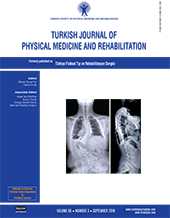Comparison of the efficacy of dry needling and trigger point injections with exercise in temporomandibular myofascial pain treatment
2 Department of Physical Therapy and Rehabilitation, İstanbul Training and Research Hospital, İstanbul, Turkey
3 Department of Otorhinolaryngology, İstanbul Training and Research Hospital, İstanbul, Turkey DOI : 10.5606/tftrd.2019.1802 Objectives: We aimed to compare the efficacy of dry needling, trigger point injection, and protection methods through physical exercise on clinical symptoms and the pain threshold in patients with temporomandibular myofascial pain.
Patients and methods: Between March 2013 and September 2013, in a random consecutive manner, a total of 63 consecutive patients (10 males, 53 females; median age 39.4±14.9 years; range, 18 to 65 years) were randomly divided into three groups: Group 1 (only exercise and protection training), Group 2 (dry needling + exercise + protection training), and Group 3 (trigger point injection + exercise + protection training). Dry needling or trigger point injection was performed for three times to the patients in Group 2 and Group 3 on a weekly basis. All patients were followed on Day 10 and at one month.
Results: A statistically significant improvement in the assessment and response variables was found for all groups, particularly for pain and functional limitation status (p<0.001). All groups were similar in terms of the improvement degree (p<0.001). Although not statistically significant, the highest improvement in the facial pain was seen in Group 3 on Day 10 (p=0.235); however, on Day 30, no significant difference was observed.
Conclusion: Our study results showed that improvement in the subjective and objective symptoms in all treatment groups. Particularly, only exercise therapy was found to be beneficial as invasive methods. We suggest that all these methods should be applied together to achieve long-term efficacy.
Keywords : Dry needling, exercise, myofascial pain, temporomandibular joint, trigger point injection

















